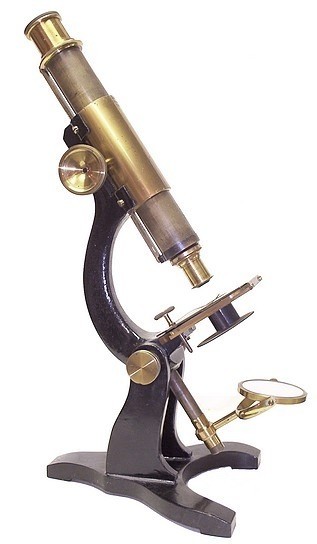
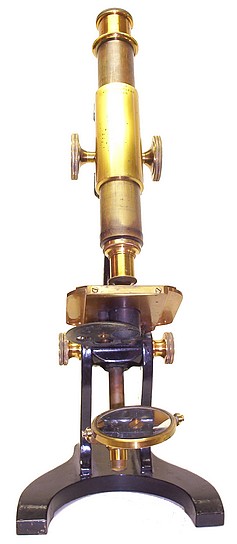
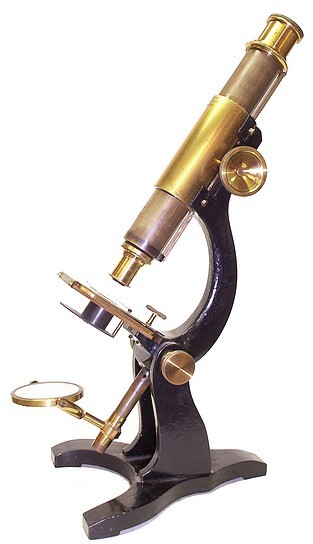
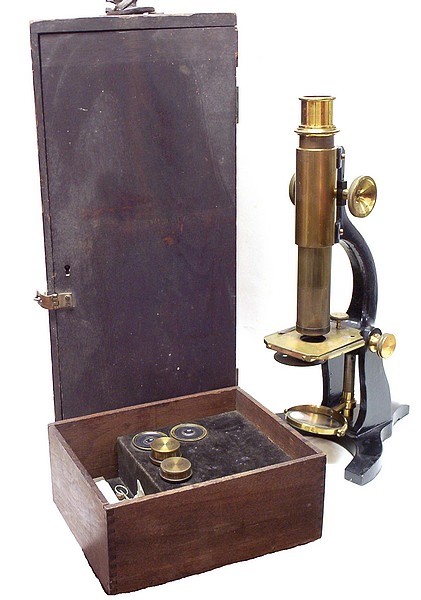
This microscope is signed on the outer tube "Boston Optical Works, Tolles. The serial number, 159, is stamped under the stage. This is an example of the Tolles Student's Model microscope dating from the 1870s. In the excerpt from the Boston Optical Works catalog shown below, it is evident that this model was sold having different variations. The example shown here is the model with rack and pinion main focus and stage fine focus. It is constructed in lacquered brass with a cast iron jappaned base and limb. It measures about 15-inches tall in the inclined position as shown in the photos. The microscope comes supplied with two eyepieces, two Tolles objectives, and the wood (walnut?) storage case with drawer.
The following is from the 1883 catalog of the Boston Optical Works, Microscope and Telescopes made by R.B. Tolles
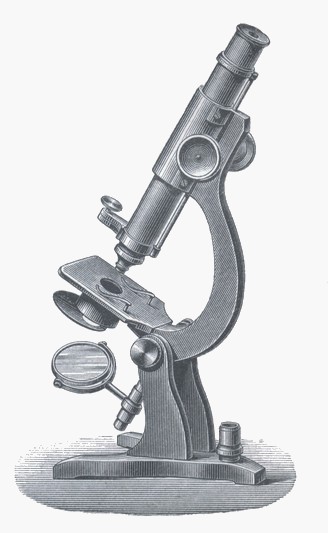
TOLLES'S STUDENT'S MICROSCOPE
15 inches high, weight 6 pounds
This instrument,
designed under the advice of several of the
Professors of the Medical School of Harvard
College and other well-known Microscopists, is of the
pattern and size most approved by experts. The base,
uprights, and curved arm are of iron, handsomely
japanned; on a trunnion joint, made on a new plan to
wear well, by which the instrument can be placed in
any position, from vertical to horizontal, with a
stop to prevent movement in either direction beyond
these points. It is furnished with a l-inch
Eye-Piece, two second-quality Objectives, of about 1
inch and 1/4 inch power, giving about 80 and 350
diameters, a plain Stage with spring clips for
holding the object slides, revolving Diaphragm,
concave Mirror, with movement to give oblique
light for illumination of opaque objects, the
mirror is removed to an upright stand; course
adjustment for focus is effected by sliding the
compound body which is held in its place by a spring,
fine adjustment by a movable plate and screw on the
stage, which is efficient with high powers. The stand
is made with all the care bestowed on his first-class
instruments, and proves satisfactory for the use of
amateurs, students, and the ordinary work of the
medical profession. The workmanship is superior to
that of any instruments of the class made in Europe.
The form is the Jackson pattern recommended by Dr. W.
B. Carpenter as the one least liable to tremor, and
is the one most approved by all American
microscopists. Price, in an upright Black Walnut
case, $50. Stand and Case alone $28.
Variations and
Additions. - Extra Eye-Pieces, 2 in. 1 1/2 und 3/4.
$4 each; a superior Camera Lucida $5; Sub-Stage for
Accessory apparatus, $5; a Sliding Stage, giving
vertical and horizontal motions by the hand, and
adapted for the use of Mathwood Finder, $15. Fine
adjustment by lever and micrometer screw, $16. Rack
and Pinion for coarse adjustment, $12, drawtube, $4.
Plain Mirror, $3. Thin glass stage to rotate on the
optical axis, $10. The stand in all brass, $10. Any
of TolIes's first quality Objectives may be used on
this instrument, and can be added to order at list
prices. Packing Boxes for transportation, $1.
The following was extracted from The National Cyclopedia of American Biography, vol. XIII, 1906
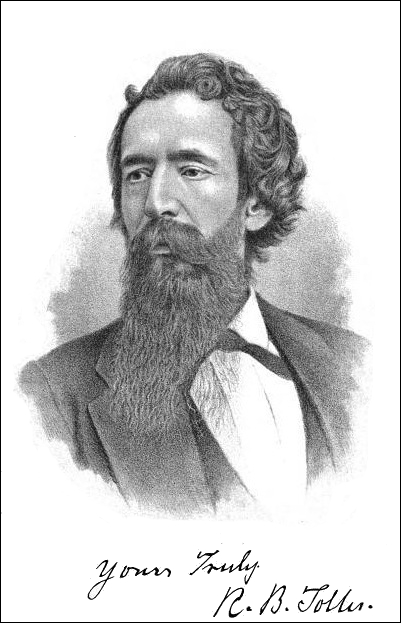
TOLLES. Robert B , lensmaker, was born in Winchester, Litchfield co., Conn., about 1825, son of Elisha and Harriet Tolles. His father was an inventor, but from lack of funds was unable to develop any of his ideas. The son was educated in the common district school and passed his boyhood at home and on his grandfather's farm near by, working to aid in supporting the family. In 1813 while in Canastota, N. Y., he accidentally visited the workshop of Charles A. Spencer, and soon afterwards he entered the service of the celebrated lensmaker as an apprentice. Under the instruction and guidance of this remarkable man young Tolles learned the special business in which he displayed such genius. In 1858 he started in business on his own account in Canastota, removing to Boston, Mass., nine years later, where he organized the Boston Optical Works. He was affiliated with this company the remainder of his life, for the first four years as superintendent and thereafter as sole proprietor. His one aim in his business was the improvement of the microscope, and his achievements in this line prove that he was well qualified for the task by his " great theoretical and practical knowledge of the science of optics, united with mechanical and inventive genius and marvelous skill of eye and hand." While still in the service of Mr. Spencer he devised a cover correction for objectives, and invented and patented a solid eye-piece. In 1858 he made his first immersion objectives, and objectives with two fronts one to be used as an immersion and the other dry, and in 1866 he obtained a patent for a stereoscopic binocular eye-piece. He invented many other devices and appliances for the microscope, as well as some telescopes remarkable for their short focal length in proportion to the diameter of object-glass and for their defining and penetrating power. The great step, however, which placed him, together with Charles A. and Herbert R. Spencer, at the head of his profession, was the construction in 1873 of an immersion one-tenth objective with an aperture greater than that corresponding to infinitely near 180 degrees in air. It was a three system lens which had an aperture of more than 110 degrees in balsam, or 1.25 N. A., and which is said to have produced " a revolution of opinion and practice among users and makers of microscopes all over the world." At the same time he also made his first lens of the duplex front formula one-fifth inch glycerine immersion of 110 degrees balsam angle. On Aug. 10, 1883, he was elected an honorary member of the American Society of Microscopists. Notwithstanding his valuable achievements, the last ten years of his life were years of suffering and hardship; he worked at his bench when he should have been in his bed, denying himself all the luxuries and many of the comforts of life. He greatly suffered from a disease of the lungs which was contracted at an early age and which caused his death. During his last illness, he had a microscope brought to his bedside and there on his deathbed examined and tested the lenses. Only a few minutes before his death he was occupied in correcting the degrees of aperture of an imaginary lens and when he reached 150 degrees, he stopped, turned his head and said faintly, "Goodbye. He was married in 1853 to Freelove S. Dickey, but was left a widower a few months later. He died in Boston, Mass. Nov. 17, 1883.
For a discussion of the life and work of Robert B. Tolles see: Three American Microscope Builders published by the American Optical Company 1945.
Other examples of the Tolles Student's
microscope are located at the following
institutions:
Collection of Historical
Scientific Instruments-Harvard
University
National Museum of Health
and Medicine-Billings Microscope
Collection
Smithsonian-National Museum
of American History
The Museum of the History
of Science, University of Oxford
Laupus Health Sciences History
Collections - Historic Microscope
Collection